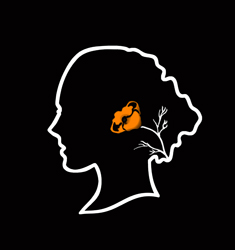By Amy Hauldren
Amy Hauldren,
UCSB Intern, Communications Major from Chicago
Artist Holli Harmon has created a portrait of Dr. Johnson that reflects both his own anthropological expertise, and the importance of the Chumash culture to the history of the Santa Barbara area. After thinking about how to represent the field of anthropology and academia in general, Holli decided that the sky was the best way to represent these ideas, because it implies a broad opening of infinite knowledge. The field of anthropology is so vast, dealing with mysteries of the past that can be uncovered to help us understand our own role as humans existing in the present and future.
She decided to paint the portrait in watercolor, a very fluid medium that allowed her to embed Chumash symbols into the work. The fluidity of the watercolor paint allowed her to experiment with the representation of the sky, a very important feature of both the Chumash culture and a symbol of Johnson’s own extensive knowledge. When examined closely, viewers can make out a couple of white figures created by the clouds of the sky. These two symbols, which closely resemble a sun and a person, are repeated in many different Chumash cave paintings. Esteemed anthropologists like Dr. Johnson are still researching the significance of these specific figures.
Harmon has painted Dr. Johnson himself in a significant and symbolic manner as well. Johnson is depicted wearing a chambray shirt with khaki pants, his uniform for work, which can also be interpreted as a cultural “uniform” commonly worn by people today. His shirt has the symbol of a condor on it, which is the emblem of the Santa Barbara Museum of Natural History, where Dr. Johnson has been the Curator of Anthropology for nearly thirty years.
As viewers, we are looking up at him, because he is a strong leader in his field. Holli has included Chumash symbols painted on the rocks below him, as well as those in the sky, representing the idea that their culture existed before him, and it will exist after him as well. The artist has positioned him in between the Earth and the sky, connecting the knowledge that we have of their cultural history with the mysteries that anthropologists are still seeking to understand. This connection is also significant because it symbolizes Johnson’s life work in connecting existing Chumash with their ancestors through DNA tests and matching old records at the Santa Barbara Mission. He connects living people to their ancestors in the heavens in order to strengthen the knowledge of their family and enhance their identity as a member of the Chumash community.


